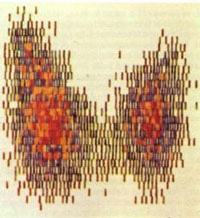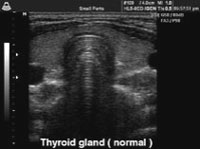Thyroid gland diseases (goiter) (Part three)
TREATMENT
The treatment depends on the identified pathology. If the goiter is caused by a lack of iodine in the diet, treatment with iodine-containing medications is advised, which can reduce the size of the goiter, but it is not always achievable. If the enlargement of the gland is caused by inflammation (Hashimoto's thyroiditis) and if it is hypothyroidism, thyroid hormones are administered to normalize the level of thyroid hormones, but even in this case the goiter can significantly reduce but not completely disappear.
If the goiter is caused by hyperthyroidism, the treatment will depend on the cause of this increased function. Many goiters, such as those with multiple nodules, may be associated with normal hormone levels in the blood. In these cases, usually no specific therapy is required. If the size of the thyroid becomes so large that it impedes normal breathing, then surgical intervention should be considered. Thyroid tumors require surgical treatment without delay.
The following techniques can be achieved through surgical intervention:
- Total removal of a nodule or cyst;
- Removal of one lobe;
- Almost total removal of the gland;
- Removal of the entire gland.
Nodular involvement of the thyroid gland
This is the most common involvement. Women are more often affected than men. In women aged 30 to 59 years, 6.4% of them are affected. In fact, the incidence may be up to 50%, but they are not diagnosed due to lack of symptoms. It is a round formation, single or multiple formations, hard or with cysts that can reach sizes from a few centimeters to large ones that press on neighboring organs. During the visit, this formation can be seen with the naked eye or can be felt.
When they are smaller, they usually have no symptoms and may be accidentally discovered during an Ultrasound examination of the neck region. The nature of thyroid nodules, in most cases, is benign (especially in women). Only 5-6% of them are of a tumoral nature (more often papillary carcinoma). The medical goal consists of differentiating the malignant nature from the benign one, from a simple or multinodular goiter, from a chronic or subacute thyroiditis.
Investigations may be laboratory, instrumental or even cytomorphological.
LABORATORY :
- Dosage of TSH; T3 and T4. (The increase in T3 suggests a toxic nodule. Low T4 values with high TRH suggest a chronic autoimmune thyroiditis with hypothyroidism).
- Dosage of Calcitonin. (To identify or exclude a thyroid carcinoma).
- Dosage of TgAb and TPOAb. (To identify a Hashimoto's thyroiditis).
 |
| Scintigraphy of the thyroid gland |
 |
| Ultrasound of the thyroid gland |
INSTRUMENTAL :
- Ultrasound of the thyroid.
- Echo-Color-Doppler.
- CT (Computed Axial Tomography) and MRI (Magnetic Resonance Imaging).
- Scintigraphy of the thyroid.
- Fine needle aspiration is of great interest to determine the differential diagnosis between Benign thyroid nodules and Malignant ones.
How it is recommended to proceed with nodular goiter
- Benign: Dynamic follow-up, and hormonal controls.
- Malignant: Surgical treatment.
- Undetermined: Surgical treatment and biopsy.
- Suspicious: Repetition of the biopsy puncture.
Note :
The medical information in this publication is presented in a summarized and somewhat simple manner, to be as understandable as possible for a wide audience. These informations, cannot replace the doctor and should not be used for self-diagnosis or self-treatment.
Getting to know this material should serve non-medical personnel, to make them attentive in this direction, to give them basic knowledge, as well as to advise them to seek timely medical attention.
This article was very impressive, especially for me who has been suffering from thyroid problems for 20 years and haven't done anything yet, only taking levothyroxine in the morning and nothing more
Sent by Luljeta Kola , më 10 October 2014 në 14:02
Please explain to us about: Thyroid papillary carcinoma
Sent by Aferdita, më 26 November 2014 në 18:18
There are no explanations for the prognosis of papillary thyroid cancer, especially for ages 20-30 years
Sent by Aferdita, më 27 November 2014 në 16:46
Hello, I am 50 years old. In July 2017, I underwent a thyroid ultrasound and was found to have cyst-covered thyroid nodules. My hormonal analysis showed the following results: Abti-TPO 898.8, whereas T.S.H was 1.84. For others like T3 and T4, there were no notable results. I am being treated with Mexanax and selenium. However, I do not feel any improvement. I experience shortness of breath, insomnia, headaches, and frequent throat tightness, but I have not lost weight. My next check-up is scheduled for November, and I don't know what to do
Sent by Beglie, më 11 September 2017 në 15:17
Dear Beglie,
We are not in Albania. Clinical consultation
I think should be done with the endocrinologist.
From what you say, I don't think it should be
Of much importance. The size and
The number of cysts should be taken into
consideration.
Viktori
Replay from Dr. Viktor QERESHNIKU, më 12 September 2017 në 02:56